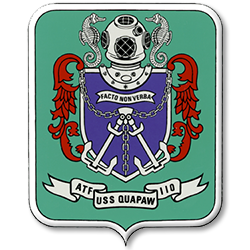The USS QUAPAW ATF 110 ( Auxiliary Tug Fleet ) was built by the United Engineering Company of Alameda, California, her keel being laid on 28 December 1942, launched on 15 May 1943, sponsored by Mrs. N.Lehman, and commissioned on 6 May, 1944, Lt. Comdr. N.H. Castle in command.
On 15 May 1944 after shakedown cruises and training she steamed for San Francisco out of San Pedro and San Diego through 10 June. She departed San Francisco 21 June enroute the Admiralty Islands. After calling at Honolulu, where she delivered an army barge, a dump scow, and a derrick, she steamed 12 July via the Ellis Islands and Milne Bay, New Guiana, arriving Manus, Admiralty Islands 14 August.
Following several harbor tow assignments, she departed 17 August with a deck cargo of 7,500 bbls. of aviation gasoline and 49 motor torpedo boat engines, and with a gasoline barge in tow. These she delivered to Mics Woendi lagoon, whence she steamed to Maffin Bay where she received orders to stand by in preparation for the landings on Morotai Island.
With a convoy of liberty ships, minesweepers, and landing craft, together with screening destroyers, QUAPAW entered Morotai Harbor the morning of 16 September 1944. She remained through 1 October, primarily engaged in retracting LSTs from the beach of Pitoe Bay.
From 20 October 1944 through 1 January 1945, QUAPAW was operating in San Pedro Bay in support of the Layte operation. Her assignments entailed salvage, firefighting, and towing operations.
Landings were made at Liagayen 9 January 1945 and QUAPAW was assigned patrol of both attack areas to render all necessary assistance. She retracted landing craft, made repairs and conducted towing operations until 21 February. She then steamed to Mindoro. She departed Mangarin Bay 26 February as a unit of Admiral W.M. Fechteler’s TG 78.2 enroute Puarto Princesa, Palawan, for initial assaults against that island. Enroute QUAPAW took LCI-683 in tow when the latter was unable to maintain convoy speed. The landing forces went ashore 28 February and QUAPAW retracted landing craft from the beaches east of Puarto Princesa and in the vicinity of the city jetty. She returned to Mangarin Bay, 5 March.
From 8 through 25 March QUAPAW participated in salvage and demolition work, assisted in clearing harbor wreckage with intervening repair and towing missions at Zamboanga, Minddanac. Further salvage, tow, and repair missions proceeded overhaul at Hollandin, New Guinea, commencing 29 May. The tug departed 25 June for Espiritu Santo, New Hebrides, from where she steamed 6 July with one section of a battleship dry-dock in tow for Samar, P.I.. With the end of hostilities she continued towing services between various ports of the Philippines, with frequent service to Manus and back through 25 April 1945.
QUAPAW departed Subic Bay for the United States 16 June 1946 arriving San Francisco, CA 14 July. After overhaul at Mare Island Naval Shipyards, continued coastal and transpacific towing operations until 21 December 1947. The QUAPAW was placed in inactive status at San Francisco until 30 April 1948 when she was placed out of commission, in reserve.
QUAPAW was recommissioned 5 December 1950 at Alameda, Calf. Lt. Fleming M. Christinan in command. After refresher training out of San Diego through January 1951 , she steamed via Bremerton , Wash. with a barracks ship in tow for Pearl Harbor. Arriving 14 February 1951, she commenced operations under Commander Service Force, Pacific.
The QUAPAW provided service at Inchon, Korea 30 April through 17 July 1951, and at Wonsan 19 July through 3 August. Towing service at Sasebo and Yokosuka, Japan were interrupted by patrol duty at Wonsan, Korea 26 October through 20 November, and by operation in the area of Cho Do and Taechong Do, Korea 17 January through 14 February 1953. QUAPAW also conducted patrols in Korean waters in March and April 1953.
The QUAPAW received four battle stars for World War II and five battle stars for the Korean conflict.
